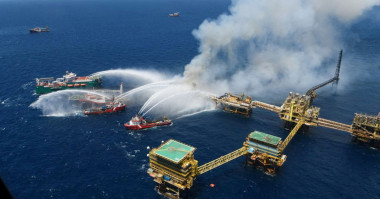How oceans became new technological battlefields
Submission Statement
Much like the air and land war, the naval theatre of the war in Ukraine has been characterized by the success of denial and deterrence technologies against traditional implements of concentrated force. While the Moskva is the flashy example of this, I’d argue that its sinking was a bit of a fluke, and even a distraction from the real impact of AShMs and sea mines–which is their strong deterrence effect on the fleet more broadly. Keeping the Russian fleet at bay from Ukraines shores has allowed the country to continue using its southern ports, which have proven to be a vital economic lifeline for both itself and the global South. By contrast, Ukraine’s USV attacks, which appear aimed specifically at attriting Russian naval capability, have had only limited or symbolic impacts thus far. This article provides an overview of the current state of the naval war, and how Ukrainian tactics and Russian counters to them are developing.
If you’d prefer mostly the same info in a video/podcast format, Perun’s video on the sinking of the Moskva is an excellent primer to many of the same issues discussed here.
This article is the sixth in a series by the Economist focused on lessons learned from the Ukraine war. The articles are written for a layman audience, but even dedicated watchers can derive value from the interviews and novel information sprinkled throughout. I plan on posting them in sequence here, and the full set of 7 articles can be found here.
Shashank Joshi is The Economist‘s defence editor. Prior to joining The Economist in 2018, he served as Senior Research Fellow at the Royal United Services Institute (RUSI) and Research Associate at Oxford University’s Changing Character of War Programme.
The inflection point came on April 14th 2022, when Ukraine sank the Moskva, a Russian cruiser, the largest loss of a warship since the Falklands war in 1982. The Black Sea Fleet promptly moved back and is still 100-150 nautical miles off the Ukrainian coast, says Admiral Neizhpapa. That has lifted the threat of an amphibious assault on Odessa: anti-tank obstacles that once guarded roads have been pushed aside and soldiers sent to other parts of the front. And it paved the way for a deal in July whereby Russia agreed to let Ukraine keep exporting grain. This helps not only Ukraine, 70% of whose pre-war trade went through the Black Sea, but also grain-importing countries of the global south.
There was nothing revolutionary about the Moskva operation. “To me, it shows the importance of proper land-based anti-ship missiles, sea mines and good intelligence,” says Niklas Granholm of FOI, Sweden’s defence research agency, “all put together in a coherent operational concept.” Luck played a role: atmospheric conditions might have let Ukraine’s radars see unusually far. So did Russia’s ineptitude. Just as its massive tank losses were down to poor tactics, not technological change making armour obsolete, so the Moskva is a cautionary tale of getting the basics right.
Being hit is one thing; failing to control the subsequent fire is another. “Damage control remains a key metric against which professional naval standards should be assessed,” concludes Alessio Patalano of King’s College London. “On the day of the sinking I was confronted by army colleagues: this must surely be the end of the idea of building big warships?” recalls Rune Andersen, chief of the Norwegian navy. “I said no: it’s the end of having a 40-year-old warship which hasn’t been updated and without trained crews.” A newer warship with better air defences and a sharper crew might have parried the Ukrainian missiles.
The maritime contest is in stalemate. Ukraine has achieved “sea denial” near its coast, stopping Russian ships coming close. But Russian warplanes roam freely, preventing Ukrainian naval vessels from coming out. The result is a “grey area” of 25,000 square kilometres in the north-west Black Sea in which neither side can “move freely”, says Admiral Neizhpapa. Russia’s Black Sea Fleet squats in relative safety, imposing a distant blockade and frequently lobbing Kalibr cruise missiles at Ukraine. Ukraine has good intelligence on the fleet’s movements thanks to America and Britain, which are fusing data from satellites and surveillance aircraft. But it lacks missiles with sufficient range to hit what it sees. That has forced it to turn to other means.
“Drones are very important elements of our warfare right now,” says Admiral Neizhpapa. “The warfare of the future is a warfare of drones.” He adds that Ukraine is learning by doing. “No other country has as much experience using naval drones.” Whether that will be enough to break Russia’s blockade is another question. A raid on Sevastopol in March seems to have been repelled, with one USV blocked by a boom and two others destroyed by machineguns. Not every USV will get through. But the technology is proving itself on another, murkier front of the naval war.

Add comment